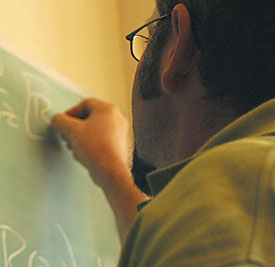 |
|
DAVID HARDEN/Arizona Daily Wildcat
|
Assistant physics professor Charles Stafford works on a mathematical equation Wednesday at the Physical and Atmospherical Sciences building.
|
|
By Ryan Johnson
Arizona Daily Wildcat
Tuesday October 15, 2002
UA physicists, chemists employ nanoscience to develop technologies for human health, convenience
One of the biggest trends in the future of computers and integrated circuits will be their rapid decrease in size and increase in power.
Electronics will be able to perform new tasks and use old tasks in revolutionary ways.
"We'll be able to have things like video-on-demand and have little things that float around our body and analyze our blood and can be used to detect disease in real time. These things seem like science fiction today, but 10 years from now they could be reality," said Seth Marder, chemistry professor.
A key part of making smaller devices is having thinner wires. The smallest devices currently use wires that are over 100 nanometers (a nanometer is a billionth of a meter) thick, but a UA physicist has been developing theories that show how wires could get much thinner.
A wire a single atom thick
A UA physicist has been working on proving that such a wire could be constructed, leading to giant leaps in circuit technology that could make computers faster and capable of more-advanced tasks 15 to 20 years from now.
"I'm working on a 1 nanometer (one billionth of a meter) scale. I'm not interested in an incremental improvement, but rather going to the ultimate limit of atomic scale electronics," said Charles Stafford, assistant professor of physics.
Gold wires play an important role in electronics such as the Pentium microprocessor because they link transistors together. Transistors are what control the flow of current when a device such as a Pentium performs a task.
Though a typical microprocessor is the size of a nickel, a signal of electrons may travel across that nickel millions of times in one second. The smaller the wires the signal travels on, the smaller the chip can be and the faster it will run.
That's why Stafford has turned his attention to atomic scale wires. He believes that, based on the current exponential rate of technology improvement, the wires will be ready for installation into integrated circuits, such as microprocessors, by 2020.
In the laboratory, scientists have actually constructed a gold wire one atom thick. Stafford pulls out a picture of an electron microscope image of one such wire. It is only three atoms long. Stafford says they've made one seven atoms long, but they need to be much longer. Stafford's theory says they can be.
"The theory predicts they could be microns long (a micron is 1000 nanometers). They could do much better than what they've done so far," he said.
Nanowires are far more robust than traditional wires because they can carry more current per unit area than a larger wire.
Nanotechnology has gotten a lot of press for how it is going to affect technology, but Stafford thinks people may be speaking too soon.
"I'm not at all pessimistic, but in a way, people are jumping the gun. Traditionally, there is a period of basic research before there is an actual technology. I'm working on the technology of 2020, not 2004," he said.
Micro-laboratories
While Stafford shows that the small wires that will take nanotechnology to its limit could exist, two chemistry professors are working together to develop new capabilities for devices on the nanoscale.
Chemistry Professor Joe Perry and Marder have been working together on several new applications.
For example, they want to put tubes on circuits that will allow liquid to flow directly onto a circuit, allowing probes to evaluate content while the liquid flows. Their hope is that this will allow for better and quicker lab analysis at the hospital, for example, in searching for signs of disease.
Once these devices become much smaller, they could become microrobots that flow in our bloodstream to make sure we're healthy.
"It will be essentially a laboratory on a chip," Perry said.
They've also been working on building compounds through a combination of chemistry, materials and optics work. They use a special laser with a material they're developing to focus laser beams.
"Making a chemical compound was akin to building a house where one was only able to move 10,000 bricks at a time. That is much more limited than if you can move one brick at a time. This is what is happening in chemistry. In the past, we could only move large groups of atoms, but now we can move small numbers of atoms at a time," said Daniel Stein, head of the physics department.
Marder and Perry have also thought about integrating lasers into circuits for telecommunications. They see a chip that routes laser beams to their destinations, such as the fibers that carry signals.
Ahead of the Curve
Stein is excited about all of the nanotechnology work going on at UA. Besides Stafford, Perry and Marder, other professors are looking in depth at the processes in the human body that nanomachines might one day emulate.
Also, Bernard Kippelen, associate professor of optical sciences, and other researchers are developing plastic-organic substrates to replace the more expensive silicon chips widely used today.
"Nanotechnology has a tremendous number of possible applications," Stein said. "We've been building up in nanoscience for a number of years. We were saying before other physics departments across the country that this would be important."

